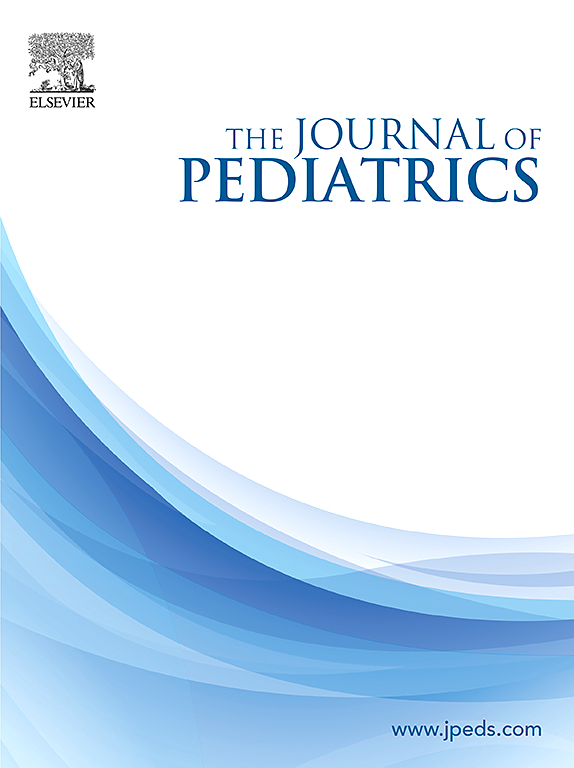Sleep Electroencephalogram in Infants Born Moderate to Late Preterm and Association with Subsequent Neurodevelopment
IF 3.5
2区 医学
Q1 PEDIATRICS
引用次数: 0
Abstract
Objective
To compare electroencephalographic (EEG) sleep patterns among infants born moderate to late preterm (MLP) and full-term and to evaluate the association of sleep EEG findings in both groups with subsequent neurodevelopment.
Study design
Infants enrolled at Cork University Maternity Hospital underwent a daytime sleep EEG at 4 months and Griffiths III developmental assessment at 18 months of corrected age. Sleep spindles were manually annotated. Sleep macrostructure (ie, total sleep and sleep stage durations, and latencies to sleep and rapid eye movement [REM]) was assessed. EEG spectral power and coherence were quantified. These features were compared between the groups. Associations between sleep features differing between groups and Griffiths III scores were investigated.
Results
The mean (SD) gestational ages for infants born MLP (30/59 females) and term (40/96 females) were 34.5 (1.3) and 39.8 (1.2) weeks, respectively. Both groups showed similar sleep spindle features. Infants born MLP had shorter stage N2 sleep duration (MLP: median [IQR] of 2.75 [1.88-4.63]; term-born: 4.50 [2.50-6.50] minutes, P < .001), had higher non-REM (NREM) power on delta 1 (MLP: 702.49 [557.46-840.67] μV2; term-born: 593.34 [449.21-749.36] μV2, P = .011] and delta 2 (MLP: 245.31 [194.17-327.77] μV2, term-born: 215.32 [164.78-283.39] μV2, P = .028) and diverging coherence. NREM delta 1 and 2 spectral power were positively associated with personal-social-emotional development (partial Spearman correlation (partial rs) = 0.25, P = .009 and partial rs = 0.25, P = .011, respectively) and gross motor development (partial rs = 0.21, P = .028 and partial rs = 0.20, P = .036, respectively). Some parameters of intrahemispherical and interhemispherical coherence were also correlated with Griffiths III subscales of development.
Conclusions
Analyzing multiple sleep EEG features at 4 months corrected age, we identified alterations in sleep biomarkers of infants born MLP compared to those born full term, likely reflecting early differences in brain organization and function and, may indicate divergent trends in brain maturation.
中度至晚期早产婴儿的睡眠脑电图及其与随后神经发育的关系。
目的:比较中度至晚期早产儿(MLP)和足月婴儿脑电图(EEG)的神经生理睡眠模式,并评估睡眠脑电图结果与随后神经发育的关系。研究设计:在科克大学妇产医院登记的婴儿在4个月时接受白天睡眠脑电图检查,在矫正年龄18个月时进行格里菲斯III发育评估。手工标注睡眠纺锤波。评估睡眠宏观结构(即总睡眠时间、睡眠阶段持续时间、睡眠潜伏期和快速眼动期)。量化脑电频谱功率和相干性。将这些特征在两组之间进行比较。研究了不同组间睡眠特征差异与Griffiths III评分之间的关系。结果:MLP出生婴儿(30/59)和足月(40/96)的平均胎龄(SD)分别为34.5(1.3)和39.8(1.2)周。两组都表现出相似的睡眠纺锤波特征。MLP患儿N2期睡眠时间较短(MLP:中位数[IQR]为2.75 [1.88-4.63];足月出生:4.50[2.50至6.50]分钟,P2;term-born: 593.34 [449.21-749.36] μV2, P=0.011]和δ 2 (MLP: 245.31 [194.17-327.77] μV2, term-born: 215.32 [164.78-283.39] μV2, P= 0.028)和发散相干性。NREM δ 1和δ 2频谱功率与个人-社会情绪发展(部分Spearman相关(rs)=0.25, P=0.009和rs=0.25, P=0.011)和大肌肉运动发展(rs=0.21, P=0.028和rs=0.20, P=0.036)呈正相关。某些半球内和半球间一致性参数也与发育的Griffiths III分量表相关。结论:通过分析4个月矫正月龄时的多次睡眠脑电图特征,我们发现了MLP婴儿睡眠生物标志物的改变,可能反映了早期大脑组织和功能的差异。与足月婴儿相比,MLP出生婴儿的这些不同睡眠特征可能表明大脑成熟的不同趋势。
本文章由计算机程序翻译,如有差异,请以英文原文为准。
求助全文
约1分钟内获得全文
求助全文
来源期刊

Journal of Pediatrics
医学-小儿科
CiteScore
6.00
自引率
2.00%
发文量
696
审稿时长
31 days
期刊介绍:
The Journal of Pediatrics is an international peer-reviewed journal that advances pediatric research and serves as a practical guide for pediatricians who manage health and diagnose and treat disorders in infants, children, and adolescents. The Journal publishes original work based on standards of excellence and expert review. The Journal seeks to publish high quality original articles that are immediately applicable to practice (basic science, translational research, evidence-based medicine), brief clinical and laboratory case reports, medical progress, expert commentary, grand rounds, insightful editorials, “classic” physical examinations, and novel insights into clinical and academic pediatric medicine related to every aspect of child health. Published monthly since 1932, The Journal of Pediatrics continues to promote the latest developments in pediatric medicine, child health, policy, and advocacy.
Topics covered in The Journal of Pediatrics include, but are not limited to:
General Pediatrics
Pediatric Subspecialties
Adolescent Medicine
Allergy and Immunology
Cardiology
Critical Care Medicine
Developmental-Behavioral Medicine
Endocrinology
Gastroenterology
Hematology-Oncology
Infectious Diseases
Neonatal-Perinatal Medicine
Nephrology
Neurology
Emergency Medicine
Pulmonology
Rheumatology
Genetics
Ethics
Health Service Research
Pediatric Hospitalist Medicine.
 求助内容:
求助内容: 应助结果提醒方式:
应助结果提醒方式:


